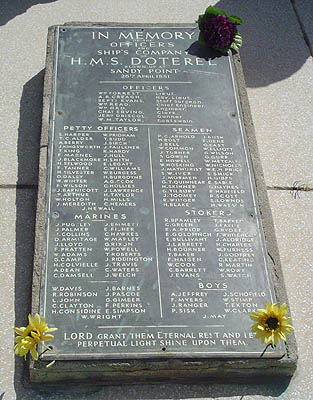H. M. S. DOTEREL, lost 26 April 1881
Memorial Plaque

Punta Arenas Cemetery (2005) |
|
On 17 January 1881, the screw sloop HMS Doterel, 1,320 tons, sailed from Sheerness (Kent), en route to the British Pacific fleet. The vessel had been built the previous year at Chatham. She carried 6 guns, and a crew of 155.
Barely one hour after mooring at Punta Arenas roads, at 10am on the 26th April 1881, an accidental explosion occurred in the forward magazine. Her upper deck and part of both sides of the hull destroyed, the vessel sank in minutes, with the loss of 143 lives [144?]. There were only 12 survivors, among them the ship's captain.
The remains of the dead were buried in the old town cemetery (on the site of the present-day Plaza Lautaro Navarro). The ceremony was conducted by the Rev. Thomas Bridges, superintendent missionary in Ushuaia, who happened to be in port at the time. A couple of months later, a monument of wood and canvas was erected over the grave by the crew of H.M.S. Turquoise.
The old cemetery was closed in September 1894, and the remains of the Roman Catholic burials were transferred to the newly opened Municipal Cemetery. In December 1936, the municipality obtained permission from the Royal Navy to relocate the Doterel burial to its current location. This was done with great formality: the cortege was accompanied by a guard of honour; and speeches were made. The original monument was likewise moved to the new location by men of H.M.S. Ajax. Subsequently, a bronze memorial was commissioned by Tom P. Jones, a prominent member of the resident British community. The plaque, which records the names of the victims, is set at ground level: it is located in the "British Section" of the cemetery (see above picture).
See also: Michael Pocock's description of events at Maritime Quest.